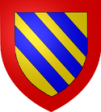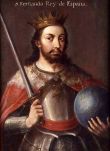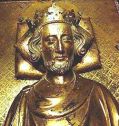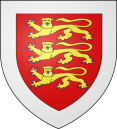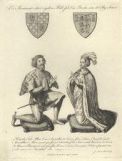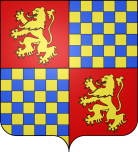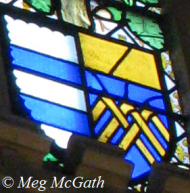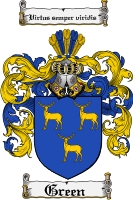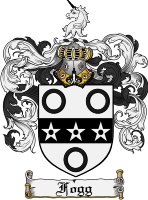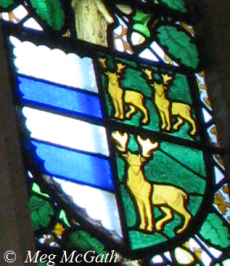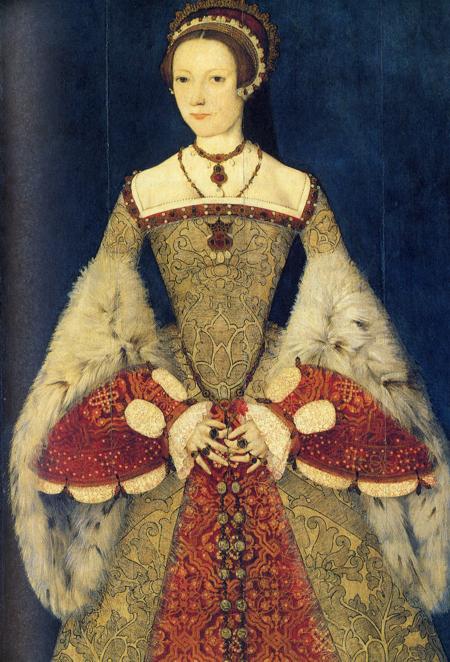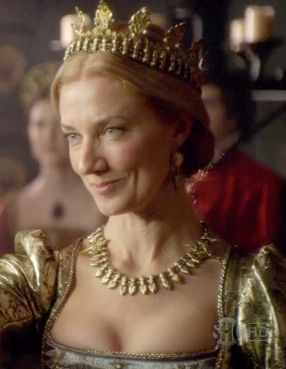 Catherine Parr's Catherine Parr's
Ancestors
Click EasyEdit to add/edit this page (Don't see the EasyEdit button above? <a href="../#signin" target="_self">Sign in</a> or <a href="../accountnew" target="_self">Sign up</a>.) | The surname of PARR was a locational name 'of Parr' a township in the parish of Prescott, County Lancashire. The name was derived from the Old English word PEARR, literally meaning the dweller at the paddock, or from residence nearby. Brian Parr, died seised of the Manor of Parre in the reign of Henry VIII (1509-1547). Catherine Parr, wife of Henry VIII was sprung of the Parrs of Parr. Richard Parr of County Lancashire, was listed in the Wills at Chester in 1637. A locational name usually denoted where a man held his land, and indicated where he actually lived. The original bearer would take his name from the village, town or the area where he dwelt. This name would identify his whole family, and would follow them wherever they moved. Following the Crusades in Europe a need was felt for a family name. This was recognized by those of noble blood, who realised the prestige and practical advantage that it would add to their status. The name could also have meant one who worked at the paddock, and these occupational surnames refer directly to the particular trade or occupation followed by the first bearer of the name. These occupations can be divided into classes such as agricultural, manufacturing, retailing and so on. In the Middle Ages, at least among the Christian population, people did not pursue specialized occupations exclusively to the extent that we do today. Smiths, millers and wrights were indeed specialists, but even they would normally have their own smallholdings for growing crops and keeping a few animals. Others were simply designated as the servant of some person of a higher social status, as a maid or parson. Most of the European surnames were formed in the thirteenth and fourteenth centuries. The process had started somewhat earlier and had continued in some places into the 19th century, but the norm is that in the tenth and eleventh centuries people did not have surnames, whereas by the fifteenth century most of the population had acquired a second name.
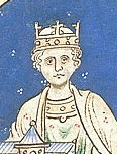
Henry II
King of England
(1133 - 1189)
His father was Geoffrey V Count of Anjou (son of Fulk of Jerusalem). His mother, Empress Matilda, was a claimant to the English throne as the daughter of Henry I of the English. He was the great-grandson of William the Conqueror, and was the first of the House of Plantagenet to rule England. Henry was the first to use the title "King of England" (as opposed to "King of the English").
| 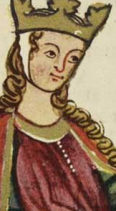
Eleanor of Aquitaine
(1122 - 1201)
She was ruler in her own right as the Duchess of Aquitaine, became Queen consort in France to Louis VII; then England as Queen Consort of Henry II and mother to John I.
Eleanor was the oldest of three children of William X, Duke of Aquitaine, whose glittering ducal court was on the leading edge of early–12th-century culture, and his wife, Aenor de Châtellerault, the daughter of Aimeric I, Viscount of Châtellerault. | 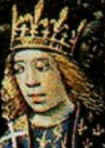
Louis VII
King of France
(1120 - 1180)
the son and successor of Louis VI and Adelaide of Maurienne. He ruled from 1137 until his death. He was a member of the House of Capet. His reign saw the beginning of the long feud between France and England. Considering the significant disparity of political leverage and financial resources between Louis VII and his Angevin (House of Plantagenet is a branch) rival, not to mention Henry II's superior military skills, Louis VII should be credited with preserving the Capetian dynasty during his feudal reign. |
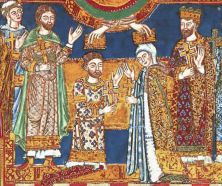 Henry II and Eleanor of Aquitaine had 8 children including: Henry II and Eleanor of Aquitaine had 8 children including:
John I, King of England; Eleanor, Queen of Castile; and Matilda of England, Duchess of Saxony
Catherine Parr had all three siblings as ancestors.
She also descended several times from Henry II's illegitimate son, William Longspee, 1st Earl of Salisbury. She also descended from Henry II's aunt, Adela of England, through her son who laid claim to the English throne as Stephen I of Blois, King of the English and his wife, Matilda of Boulogne. She also descended from Adela's other son, Theobald II of Champagne.
Catherine Parr also descended from
Henry II's half-brother, Hamelin Plantagenet (de Warenne), the 5th Earl of Surrey who married Isabel de Warenne, suo jure (in her own right) 4th Countess of Surrey. The Warenne line descended from Henry I of France.
Catherine's paternal line, unlike the Boleyn's or Seymour's, actually descended from royalty through Geoffrey of Anjou; King John of England; Llewelyn Ap 'The Great'; Adeliza of Louvain (queen consort of England to Henry I); Henry I of England by several illegitimate children; Henry II of England (by Eleanor of England); Infanta Berenguela of León, Empress of Constantinople; William 'the Lion' of Scotland; David I of Scotland.
King William of Scotland's illegitimate child, Isabel of Dunkeld, married Sir Robert de Ros, 1st Baron Helmsley. By William's paternal line she was also a descendant of David I of Scotland, brother of Matilda, queen consort of Henry I of England.
Catherine descended from two children of Eleanor of England, Infanta Beregaria of Castile and Leon and Infanta Blanche of Castile (who became wife of Louis VIII, King of France).
Eleanor and Louis VII had 2 children. Catherine is a descendant of both children.Louis VII married 3 times.
- Eleanor of Aquitaine
- Infanta Constance of Castile (daughter of Alphonse VII, King of Galicia, León and Castile, and Berenguela of Barcelona).
- Adèle of Champagne (daughter of Theobald II, Count of Champagne and Matilda of Carinthia).
*Catherine descends from all of Louis' wives. |
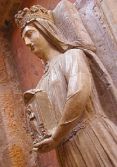
Berengaria
Queen of Castile and Leon
(1180 - 1246)
Daughter of Eleanor of England, Queen of Castille. She was Queen Regent of Castile in her own right, but abdicated in favor of her son in 1217.
Mother of Ferdinand III and Infanta Berenguela of León, Empress of Constantinople
| 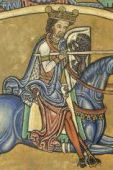
Alfonso IX
King of León and Galicia
(1171 – 1230)
Father of Ferdinand III and Infanta Berenguela of León, Empress of Constantinople
| 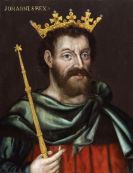
John
King of England
(1167 - 1216)
Father of Henry III and an illegitimate daughter Lady Joan of Wales (wife of Llywelyn the Great, Prince of Wales). | 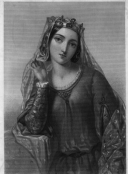
Isabella of Angoulême
(1188 - 1246)
She was suo jure Countess of Angoulême, daughter of Aymer Taillefer, Count of Angoulême, by Alice of Courtenay.
Her second husband was Hugh X of Lusignan.
Mother of Henry III and Alice, Countess of Surrey de Lusignan
|
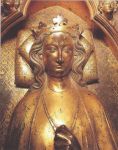
Eleanor of Castile
(1241-1290)
1st Wife of
Edward I
Daughter of Ferdinand III King of Castile, Galicia & León.
Edward married Eleanor on October 18, 1254; at the Abbey of Las Huelgas, Burgos, Castile (Spain). She was dark haired and beautiful and they had 16 children, of which 7 survived into adulthood. Eleanor was buried in Westminster Abbey in London. To show his love for his departed wife, Edward erected 12 crosses along the route of her funeral procession from Lincoln to Westminster.
Mother of King Edward II, Joan of Acre, Elizabeth of Rhuddlan
| 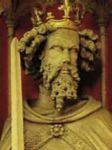
Edward I
King of England
(1239 - 1307)
Edward I was a tall man of six feet two inches (1.88m), with long arms and legs from which his nick-name, "Longshanks", was derived. His hair was black like his Provencal mother's, his complexion swarthy and his eyes fiery in anger. Edward spoke with a pronounced lisp, but possessed the Plantagenet temper in full measure.
*Catherine is descended from both siblings and their cousin Henry Plantagenet
Father of Edward II, Joan of Acre, Prince Edmund of Woodstock, Elizabeth of Rhuddlan | 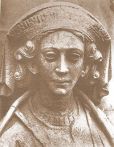
Margaret of France
(c.1279 – 1318)
2nd Wife of
Edward I
Daughter of Phillip III, King of France and Maria of Brabant. The King remarried at the age of 60, his second wife was 17. They had 3 children, Thomas of Brotherton, Edmund of Woodstock and daughter, named Eleanor for the king's first wife. Despite their disparate ages the pair grew extremely close and Eleanor built up a close relationship with Edward's heir, his eldest surviving son by his first marriage, Edward, Prince of Wales (later Edward II) who was but two years younger than herself.
Mother of Prince Edmund of Woodstock
| 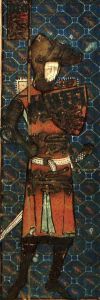
Edmund "Crouchback"
Plantagenet
(1245 - 1296
1st Earl of Lancaster
Prince of England
Younger Brother of King Edward I
Gained the title of
King Edmund of Sicily on 7 January 1254 and abdicated in 1263. It is believed his nickname is derived from "crossback" due to his participation in the Crusades. As a result of his marriage, Edmund was styled as Comte de Brie and Comte de Champagne in 1276
Father of Henry Plantagenet, 3rd Earl of Lancaster
| 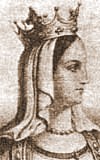
Blanche de Artois
(1248 -1302)
2nd wife of
Edmund "Crouchback"
Her paternal grandparents were King Louis VIII of France and Blanche of Castile. Her maternal grandparents were Henry II, Duke of Brabant and Marie of Hohenstaufen, daughter of Philip of Swabia.
She had previously married to King Henry of Navarre and had ruled after his death in 1274, as Queen Regent of Navarre in right of their daughter, Joan of Navarre.
Catherine was a descendant of both husbands of Blanche. Through Henry she descended from Queen Regent Joanna of Navarre and Philip IV, King of France through their daughter who became Queen Isabella of England.
Mother of Henry Plantagenet, 3rd Earl of Lancaster and Joanna of Navarre
|
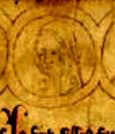
Joan of Acre, Countess of Hertford
Princess of England
Joan was married twice.
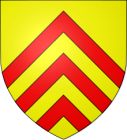
Gilbert de Clare, Earl of Gloucester
(2 September 1243 – 7 December 1295)
who was a powerful English noble. *Catherine
descended through their daughter; Eleanor de Clare, Lady Despencer, who married Sir Hugh le Despencer.
(See Richard 'Copped Hat', 10th Earl of Arundel Fitzalan)
She also descended from Lady Margaret de Clare, Countess of Gloucester, ancestress of the 5th Baron Ferrers of Chartley
Joan's second husband was the notorious
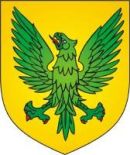
Ralph de Monthermer, 1st Baron Monthermer, Earl of Hertford, Earl of Gloucester, Earl of Atholl (c. 1270 - 5 April 1325)
Parents of Sir Thomas Monthermer
2nd Baron
| 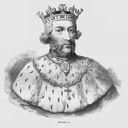 Edward II Edward II
King of England
(25 April 1284 – 21 September 1327)
Called Edward of Carnarvon, was King of England from 1307 until he was deposed by his wife Isabella in January 1327. He was the seventh Plantagenet King in a line that started with Henry II.
&
Isabella of France
(c. 1295 – 22 August 1358)

Sometimes described as the She-wolf of France, was the Queen consort of Edward II of England and mother of Edward III. She was the youngest surviving child and only surviving daughter of Philip IV King of France
and Joan I of Navarre.
Parents of Edward III
King of England
| 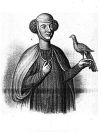
Elizabeth of Rhuddlan
Princess of England
Countess of Holland, Countess of Hereford
(1282 - 1316)
She was the eighth daughter of Edward I of England and Eleanor of Castile. Of all of her siblings, she was closest to her younger brother Edward II of England, as they were only two years apart in age. Her first marriage was to John I, Count of Holland. They had no children. Through her second husband she had eleven children, three died as infants. Of the remaining eight, five married
&
Humphrey de Bohun,
4th Earl of Hereford
(1276 - 1321/22)
From an important Norman family of the Welsh Marches and was considered one of the most rema rkable men of his time.
Parents of
Lady Eleanor, Countess of Ormonde de Bohun
| Edmund of Woodstock Plantagenet, Earl of Kent
Prince of England
(5 August 1301 – 19 March 1330)
The son of Edward I Longshanks, King of England and his second wife, Margaret of France. He was 62 years younger than his father, who died when Edmund of Woodstock was only seven. Kent was sentenced to death by Sir Robert de Hauville and by order of the Regents the Earl of March and Queen Isabella for treason, having supported his half-brother, the deposed King Edward II.
& Margaret Wake, Baroness Wake of Liddell Countess of Kent
(c. 1297 – 29 September 1349)
She was the daughter of John Wake, 1st Baron Wake of Liddell, and was descended directly from Llywelyn the Great, Prince of Gwynedd. Her mother was Joan de Fiennes, making her a cousin of Roger Mortimer, 1st Earl of March.
Parents of Joan of Kent Plantagenet, Princess of Wales and Aquitaine
| 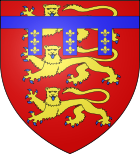
Henry Plantagenet
3rd Earl of Lancaster
(1281 - 1345)
He was the son of Edmund 'Crouchback' Plantagenet and a nephew of Edward I.
&
Maud Chaworth
(1282 -1322)
Wealthy Heiress of Sir Patrick de Chaworth, Baron of Kidwelly and Isabella de Beauchamp
Parents of Eleanor of Lancaster Plantagenet
Eleanor of Lancaster Plantagenet Countess of Arundel (11 September 1318 - 11 January 1372)
Married twice.
1) John de Beaumont,
2nd Baron (d.1342)
2) Richard FitzAlan, "Copped Hat",
10th Earl of Arundel (c. 1306 – 24 January 1376)
Parents of Lady Alice Fitzalan, Countess of Kent
(see below, wife of the 2nd Earl of Kent)
|
|
|
| Richard "Copped Hat" Fitzalan10th Earl of Arundel(c. 1306 – 24 January 1376)
and
Isabel Despencer
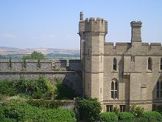 Richard Fitzalan was an Enlgish nobleman and a medieval military leader. FitzAlan was the eldest son of Edmund FitzAlan, 9th Earl of Arundel and Alice de Warenne. His maternal grandparents were William de Warenne and Joan de Vere. Richard was first married to Isabel DeSpencer, daughter of Hugh "the Younger" Despencer. He divorced Isabel in order to marry Eleanor of Lancaster; by an annulment, their child was bastardized. The Despencer's fell out of favour during Edward II's reign. Richard's father was executed and for a time Richard was denied his inheritance. In 1347, he succeeded to the Earldom of Surrey.
| Catherine's Green ancestor's descended from Richard FitzAlan's sister as well,
Mary FitzAlan
(d.29 Aug 1396)
and
Aline FitzAlan
(1320-1386)
who both married into the Strange family.
Mary married John, 4th Lord Strange of Blackmere. Their daughter Ankaret inherited the barony in her own right. She married Richard Talbot, 4th Baron. The two were parents to Lady Mary Talbot who married Sir Thomas Green.
Aline married Roger, 5th Lord Strange of Knockin. The two were ancestors to the Willoughby Barons of Eresby from whom Catherine's FitzHugh ancestors descended. | 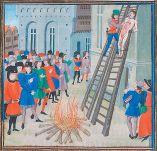
Hugh "the Younger" Despenser
(1286-1326)
and
Lady Eleanor de Clare (1292-1337)
Queen Isabella, the consort to Edward II had a special dislike for Hugh Despenser the younger. Various historians have suggested, and it is commonly believed, that he and Edward had an ongoing sexual relationship. The Despencer's were against Isabella and her lover Roger Mortimer who took over England in 1326. The Despencer's were quickly crushed and Hugh's father was hung while he was sentenced to die the death of a thief, being hanged, drawn, and quartered. Hugh had married Lady Eleanor de Clare, daughter Joan of Acre; thus making her a niece of Edward II. This alliance did not help the Despencer's and the children had to regain their titles in 1338.
They were ancestors of Margaret Despencer, Baroness Ferrers of Chartley, wife of the 5th Baron. |
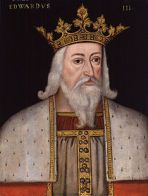 Edward III Edward III
King of England
(13 November 1312 – 21 June 1377)
Father of John of Gaunt Plantagenet, Duke of Lancaster & Titular King of Castile
| 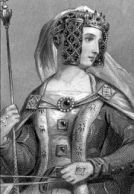 Philippa of Hainault Philippa of Hainault
Queen Consort of England
(24 June 1314 – 15 August 1369)
The daughter of William I, Count of Holland and Joan of Valois
Mother of John of Gaunt Plantagenet, Duke of Lancaster & Titular King of Castile
|
|
|
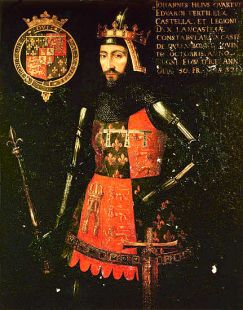 Royal, handsome, intelligent, athletic, powerful and wealthy, John of Gaunt (a Plantagenet) strode across the stage of 14th century England in a blaze of charisma. He was the 3rd son of an English King, Edward III, and the father of another, Henry IV. His legitimate daughters married into the royal families of Portugal and Spain, and were Queens and the mothers of Kings.
John of Gaunt's power and wealth were greatly enhanced by two very advantageous marriages, but he made the most of all the opportunities which came his way.
As a young man, he married the heiress Blanche of Lancaster. Through her, he became Duke of Lancaster and the wealthiest man in England.Together they had three children, including Henry Bollingbroke, the future Henry IV.
After Blanche's death from the Plague, John of Gaunt married Constance of Castile, the usurped and exiled heir to the throne of Castile. He claimed the Crown of Castile by right of his wife.In his old age, John of Gaunt married for a third time. No Duchess or Queen this time, rather he married his long-term mistress.
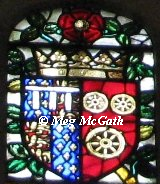 Katherine Swynford Katherine Swynford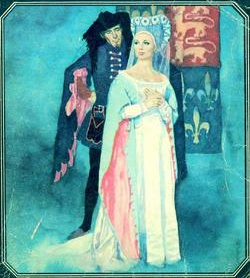 was the daughter of an obscure, lowly knight, and the widow of another. She was also the mother of John of Gaunt's four bastard children, the Beauforts. The children were declared legitimate in 1390 (and Gaunt married their mother in January 1396), this was on the condition that they be barred from ascending the throne. Undeterred by this, upon the failure of the primary Lancastrian line, the Tudors claimed precedence to the Yorks and eventually succeeded them. was the daughter of an obscure, lowly knight, and the widow of another. She was also the mother of John of Gaunt's four bastard children, the Beauforts. The children were declared legitimate in 1390 (and Gaunt married their mother in January 1396), this was on the condition that they be barred from ascending the throne. Undeterred by this, upon the failure of the primary Lancastrian line, the Tudors claimed precedence to the Yorks and eventually succeeded them.
John of Gaunt and Katherine Swynford had four children during their affair:
- John Beaufort, 1st Earl of Somerset, who married Margaret Holland *Henry VIII descended from this line.
- Henry, Cardinal Beaufort
- Thomas Beaufort, Duke of Exeter, who married Margaret Neville
- Lady Joan Beaufort, who married (1) Robert Ferrers, 3rd Baron Ferrers of Oversley and (2) Sir Ralph Neville, 1st Earl of Westmoreland. *Henry VIII and Catherine Parr descended from this line.
They were given the surname "Beaufort" as some of John of Gaunt's lost French lands were Beaufort in Champagne. As they were unlikely to be retrieved, this did not threaten the inheritance of John's legitimate children, particularly his heir, Henry of Bolingbroke (Henry IV of England).
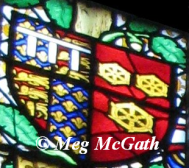 From this unlikely couple came the House of Tudor - Henry VII's mother was Margaret Beaufort and Henry VIII's mother descended from Cecily Neville, Duchess of York who was the daughter of Lady Joan Beaufort and her second husband. From this unlikely couple came the House of Tudor - Henry VII's mother was Margaret Beaufort and Henry VIII's mother descended from Cecily Neville, Duchess of York who was the daughter of Lady Joan Beaufort and her second husband.
*Catherine Parr descended from Lady Joan Beaufort and Ralph Neville, 1st Earl of Westmoreland. |
Sir Thomas Monthermer
2nd Baron
(1301 - ABT 1341)
&
Margaret Teyes
Parents of Lady Margaret Monthermer
|
Lady Eleanor de Bohun
(1304 – 1363)
&
James Butler,
1st Earl of Ormonde
(c. 1305 – 1338)
He was an ancestor of Anne Boleyn.
Parents of
Lady Petronilla Butler
| Princess Joan, Countess of Kent,
Princess of Wales and Aquitaine
(28 September 1328 – 7 August 1385)
Mother
Sir Thomas Holland, 2nd Earl of Kent
|
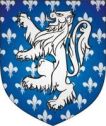
Sir Thomas Holland,
1st Earl of Kent KG (c. 1314 – 26 December 1360)
Father of Sir Thomas Holland, 2nd Earl of Kent
|
Princess Joan of Kent and Sir Thomas Holland, 1st Earl of Kent 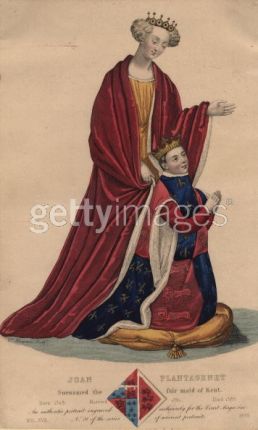 Princess Joan was heiress to her father Edmund of Woodstock who was executed after the deposition of her uncle, Edward II. She inherited her father's title of Earl of Kent and was Countess of Kent in her own right. She married her first husband, Sir Thomas Holland, around the age of twelve. Since the couple did not get consent of the crown, Joan was forced to marry Sir William Montague, 2nd Earl of Salisbury while her husband was overseas. When Holland returned from the Crusades, he appealed to the Pope for the return of his wife and confessed to the King. Salisbury decided to keep Joan captive in his home rather than let her return to Holland. In 1349, Pope Clement VI annulled Joan's marriage to Salisbury and had her sent back to Holland. They had several children before Holland died in 1360. Joan's third marriage was to Edward 'the black', Prince of Wales, son and heir of Edward III. Joan had been a favoured ward of the King and his wife, but her living ex-husband was an issue when it came to inheritance. Another issue which arose was their forbidden degree of consanguinity [Joan's father was the uncle of King Edward], a dispensation from the Pope had to be granted. The two were legally married at Windsor on 10 October 1361. The couple had two children, Edward and Richard. The eldest died around age 6 while the couple was ruling in Bordeaux as Prince and Princess of Aquitaine. The couple returned to England in 1371 where the plague had become an issue. Princess Joan was heiress to her father Edmund of Woodstock who was executed after the deposition of her uncle, Edward II. She inherited her father's title of Earl of Kent and was Countess of Kent in her own right. She married her first husband, Sir Thomas Holland, around the age of twelve. Since the couple did not get consent of the crown, Joan was forced to marry Sir William Montague, 2nd Earl of Salisbury while her husband was overseas. When Holland returned from the Crusades, he appealed to the Pope for the return of his wife and confessed to the King. Salisbury decided to keep Joan captive in his home rather than let her return to Holland. In 1349, Pope Clement VI annulled Joan's marriage to Salisbury and had her sent back to Holland. They had several children before Holland died in 1360. Joan's third marriage was to Edward 'the black', Prince of Wales, son and heir of Edward III. Joan had been a favoured ward of the King and his wife, but her living ex-husband was an issue when it came to inheritance. Another issue which arose was their forbidden degree of consanguinity [Joan's father was the uncle of King Edward], a dispensation from the Pope had to be granted. The two were legally married at Windsor on 10 October 1361. The couple had two children, Edward and Richard. The eldest died around age 6 while the couple was ruling in Bordeaux as Prince and Princess of Aquitaine. The couple returned to England in 1371 where the plague had become an issue. 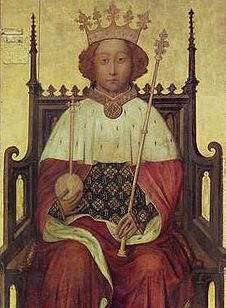 Edward was a Prince who enjoyed fighting and was usually pre-occupied with some campaign. In 1371, he attempted one final campaign to regain his father's French possessions. On 7 June 1376, he died at Westminster, a week before his forty-six birthday. Joan's son by the Prince, young Richard, became heir to his grandfather Edward III. Edward died circa a year after his son and Richard was crowned King at the age of ten. [Richard II; pictured right] Edward was a Prince who enjoyed fighting and was usually pre-occupied with some campaign. In 1371, he attempted one final campaign to regain his father's French possessions. On 7 June 1376, he died at Westminster, a week before his forty-six birthday. Joan's son by the Prince, young Richard, became heir to his grandfather Edward III. Edward died circa a year after his son and Richard was crowned King at the age of ten. [Richard II; pictured right]
Sir Thomas Holland was an English nobleman and military commander during the Hundred Years' War. He was from a gentry family in Holland, Lancashire. He was a son of Robert Holland and Maud la Zouche.
He had the honour of being chosen as one of the founders of the Most Noble Order of the Garter. He secretly married Joan of Kent in a clandestine marriage without first gaining the royal consent necessary for couples of their rank; therefore while he was serving in the wars Joan's parents forced her to into another marriage with Sir William Montague (mentioned above). |
Lady Margaret Month-
ermer
(1329 - 1395)
Mother of Sir John Montague, 3rd Earl of Salisbury
| Sir John Montague
(1329 - 1390)
The younger brother of William Montacute, 2nd Earl of Salisbury. His father was William Montagu(alias Montacute), 1st Earl of Salisbury and King of the Isle of Man. He was an English nobleman and loyal servant of King Edward III.
Father of Sir John Montague, 3rd Earl of Salisbury
| John de Ferrers, 3rd Baron Ferrers of Chartley
He inherited the title of Baron Ferrers of Chartley upon his father's death in 1350 but was never summoned to parliament. Despite his youth, John fought in Gascony for Edward III in 1345.
Father of Sir Robert Ferrers, 4th Baron Ferrers of Chartley
| Lady Elizabeth de Stafford
(1342 – 7 Aug 1375)
She was the widow of Fulk le Strange and daughter of Ralph Stafford, 1st Earl of Stafford and Margaret de Audley, a daughter of Hugh de Audley, 1st Earl of Gloucester.
Mother of Sir Robert Ferrers, 4th Baron Ferrers of Chartley | Lady Petronilla
Butler
(ABT 1332 - 1387)
Her father was the 1st of the Earls of Ormonde.
Mother of Richard Talbot,
4th Baron Talbot
| Sir Gilbert Talbot,
3rd Baron Talbot
(1332 - 1387)
Son of Sir Richard Talbot,
2nd Baron Talbot and Elizabeth Comyn
Father of Richard Talbot, 4th Baron Talbot
| Sir Thomas Holland, 2nd Earl of Kent
(1350 – 25 April 1397)
He was an English nobleman and half-brother to Richard II of England.
Father of Lady Eleanor of Holland
| Lady Alice Fitzalan
(1350 - 17 March 1416)
(the above Lady Alice Fitzalan of Eleanor of Lancaster and Richard Fitzalan, 10th Earl of Arundel)
In 1388, she was appointed a Lady of the Garter.
Mother of Lady Eleanor Holland
|
Sir Thomas Holland and Lady Alice Fitzalan had 10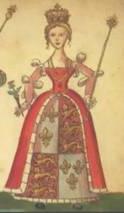 children. Through them they were grandparents of Lady Anne Mortimer making them ancestors of King Edward IV and King Richard III. Through their daughter, Lady Margaret Holland, who married John Beaufort, 1st Earl of Somerset, King Henry VII was their descendant. They were also the maternal grandparents of Lady Joan Beaufort, Queen consort of Scotland to James I [pictured right] who was an ancestress of Mary, Queen of Scots and many other Scottish nobles due to her second marriage to Sir James Stewart, Knight of Lorn. *Catherine was a descendant of Lady Eleanor Holland. children. Through them they were grandparents of Lady Anne Mortimer making them ancestors of King Edward IV and King Richard III. Through their daughter, Lady Margaret Holland, who married John Beaufort, 1st Earl of Somerset, King Henry VII was their descendant. They were also the maternal grandparents of Lady Joan Beaufort, Queen consort of Scotland to James I [pictured right] who was an ancestress of Mary, Queen of Scots and many other Scottish nobles due to her second marriage to Sir James Stewart, Knight of Lorn. *Catherine was a descendant of Lady Eleanor Holland.
|
Sir John Montague,
3rd Earl of Salisbury
(1350 – 5 January 1400)
Sir John and Maud were the parents of 6 children, including Anne Montague, Duchess of Exeter
(ancestress of Anne Boleyn).
Father of Sir Thomas Montague, 4th Earl of Salisbury
| Maud Francis
(1368 - 1424)
daughter of
Sir Adam Francis,
Lord Mayor of London and Agnes Champnes
She was the foster mother of the future King Henry V of England, after the death of his mother.
Mother of Sir Thomas Montague, 4th Earl of Salisbury
| Sir Robert Ferrers,
4th Baron Ferrers of Chartley
(1358 – 1413)
Father of Lady Philippa de Ferrers
| Lady Margaret Despencer
(AFT 1357 - ?)
Her parents were
Sir Edward Le Despenser and Elizabeth, suo jure 3rd Baroness Burghersh.
Mother of Lady Philippa de Ferrers
| Richard Talbot,
4th Baron Talbot
(1361 - ?)
Father of Mary Talbot
| Ankaret Le Strange,
Baroness Strange of Blackmere
(1361-1413)
She was Baroness in her own right. Her parents were Sir John Le Strange, 4th Baron Strange of Blackmere and Mary Fitzalan, daughter of Sir Richard 'Copped Hat' and his wife Eleanor of Lancaster.
Mother of Mary Talbot
|
Sir Thomas Greene IV
of Greens Norton
(d. 1417)
Father of Sir Thomas Greene V | Hon. Mary Talbot
(d. 13 April 1434)
Lady Greene of Greens Norton
Mother of Sir Thomas Greene V |
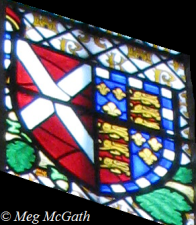
Lady Joan Beaufort, Countess of Westmoreland
(1375 - 13 November 1440)
Daughter of John of Gaunt Plantagenet,
Duke of Lancaster, Titular King of Castile and
Prince of England
and Katherine Swynford Roet
& Sir Ralph Neville,
Earl of Westmoreland
(1363 - 21 October 1425)
Son of Sir John Neville, 3rd Baron of Raby and
Lady Maud Percy 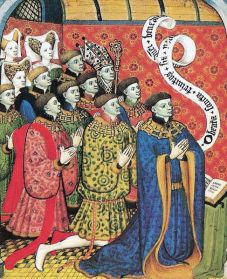 Joan Beaufort Joan Beaufort
and
Ralph Neville
were the grandparents of Edward IV and Richard III of England, whom Henry VII defeated to take the throne. (Henry then married Elizabeth of York, daughter of Edward IV, and their son became King Henry VIII). She was also the grandmother of Richard Neville, 16th Earl of Warwick, 'the Kingmaker' making her a great-grandmother of Anne Neville, the last Plantagenet queen of England.
Other ancestors include
Edward Stafford, 3rd Duke of Buckingham; Anne Stafford, Countess of Huntingdon (portrayed as Anna Buckingham in the series)
George Talbot, 4th Earl of Shrewsbury
Parents of Sir Richard Neville,
5th Earl of Salisbury
| 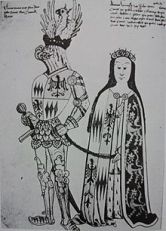
Sir Thomas Montague,
4th Earl of Salisbury
(13 June 1388 – 3 November 1428)
&
Lady Eleanor Holland,
Countess of Salisbury (1386- after 1413)
Eleanor was the daughter of the 2nd Earl of Kent and Lady Alice Fitzalan.
(above)
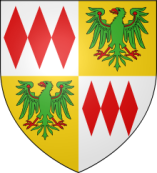
Their only child was a daughter; Lady Alice Montague, the suo jure Countess of Salisbury having succeeded to the title in her own right in 1428.
Montacute was present at the Battle of Agincourt with Henry V. He was one of the most important English commanders during the Hundred Years' War. He married twice, first (as mentioned above) to Eleanor Holland, and second to Alice Chaucer, daughter of Thomas Chaucer and granddaughter of Geoffrey Chaucer (author of 'The Canterbury Tales'). It was Geoffrey who married the sister of Queen Philippa of England, consort to Edward III.
After the death of Thomas Montacute, Alice Chaucer remarried William Pole, 1st Duke of Suffolk. They were parents to John Pole, 2nd Duke who was briefly married to Lady Margaret Beaufort, grandmother to King Henry VIII. It was this line that gave King Henry quite a deal of grief after the 2nd Duke remarried Elizabeth of York, Duchess of Suffolk, daughter to Cecily Neville (daughter of Joan Beaufort and Ralph Neville) and Richard Plantagenet, 3rd Duke of York. This union produced several possible heirs to the throne of England after the 2nd Duke's son John Pole, Earl of Lincoln was designated as Richard III's heir.
Parents of Lady Alice Montague, suo jure 5th Countess of Salisbury
|
| Catherine's great great grandparents | Sir John Parr of Kendal
(1383 - 1409)
Father of Sir Thomas Parr
| Agnes Crophull
(1366 - 1421)
Mother of Sir Thomas Parr
| Sir Richard Neville,
5th Earl of Salisbury
(1400 – 31 December 1460)
Father of Lady Alice Neville | Lady Alice Montague, suo jure 5th Countess of Salisbury
(1407 – before 9 December 1462)
Mother of Lady Alice Neville
| Sir Thomas Greene V
(10 Feb 1400 - 18 Jan 1462)
Father of Sir Thomas Greene VI
| Lady Philippa de Ferrers
(b. circa 1400)
Mother of Sir Thomas Greene VI
| Sir William
of Bishop-bourne Hawte
(1390 - 1462)
Father of Alice Hawte
| Joan Elizabeth Woodville
(born c. 1405)
She was the aunt of Elizabeth Woodville, Queen Consort to Edward IV King of England
Mother of Alice Hawte
|
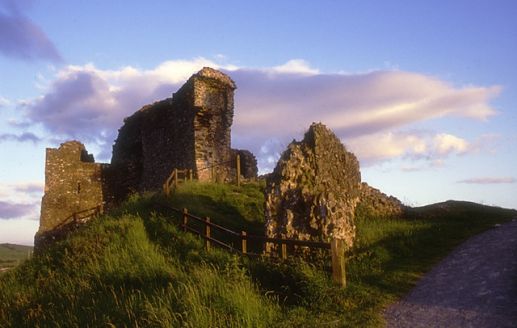 Sir John Parr was the son of Sir William Parr and Elizabeth de Ros. Parr married in 1383 Elizabeth, daughter of Sir John de Ros, and granddaughter and heiress of Sir Thomas do Ros, Baron of Kendal and had livery of her inheritance. On the accession of the Duke of Lancaster as Henry IV of England, Sir William stood so high in the estimation of the new monarch that he was deputed with the bishop of St. Asaph to announce the revolution to the court of Spain. He died on 4 October 1405 being then seized of the fourth part of the manor of Kirby in Kendal. In right of the heiress of Ros and was succeeded by his eldest son, Sir John of Kendal.
Agnes Crophull, Lady Parr was the sole heir of her father Sir Thomas Crophull. She married firstly to Sir Walter Devereux and secondly to Sir John Parr of Kendal. It was through Agnes' first marriage to Sir Walter, that Sir Walter Devereux, Earl of Essex, husband to Lettice Knollys, descended. Agnes descended from Henry II of England by Princess Eleanor, Queen of Castile; King John of England; and King David I of Scotland, son of King Malcolm III of Scots and St. Margaret of Wessex, Queen of Scots. |
Sir Thomas Parr
of Kendal
(1407 - 1461)
Father of Sir William, Baron Parr
| Alice Tunstall
(? - ?)
Daughter of Sir Thomas Tunstall of Thurland Castle and Isabel Harrington
Mother of Sir William, Baron Parr
| Sir Henry Fitzhugh
5th Baron Fitzhugh of Ravensworth
(ABT 1429
- Jun 1472)
Son of the 4th Baron and Margery Willoughby, whose father was an ancestor of the Duchess of Suffolk
He was a descendant of King John of England and Beatrice of England, Duchess of Brittany.
Father of Hon. Elizabeth Fitzhugh
| Lady Alice Neville
Baroness Fitzhugh of Ravensworth
(1430
- 22 Nov 1503)
sister of "Warwick, the Kingmaker"
Mother of Hon. Elizabeth Fitzhugh
| Sir Thomas Greene VI
(7 Dec 1434 - 9 Sep 1462)
Father of Sir Thomas Greene VII
| Maud "Matilda" Throck-morton
Daughter of Sir John Throck-morton and Eleanor Spiney
Mother of Sir Thomas Greene VII
| Sir John Fogge
of Ashton
(c.1417 - 1490)
Father of Joan Fogge
| Alice Hawte
(? - ?)
Her mother was Joan Woodville, aunt to Queen Elizabeth; she was thus a 1st cousin of the queen.
Mother of Joan Fogge
|  Sir Thomas Parr took an active part in the wars of the Roses on the Yorkist side; he was attainted in 1459, with the other leading Yorkists. Sir Thomas Parr took an active part in the wars of the Roses on the Yorkist side; he was attainted in 1459, with the other leading Yorkists.
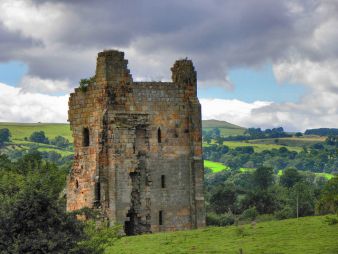 Lady Alice Neville and Sir Henry Fitzhugh, 5th Baron Fitzhugh of Ravensworth Lady Alice Neville and Sir Henry Fitzhugh, 5th Baron Fitzhugh of Ravensworth 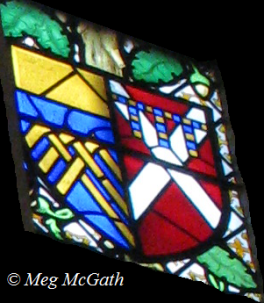 The title Baron FitzHugh of Ravensworth was created in the Peerage of England in 1321, for Sir Henry FitzHugh. The title passed through the male line until the death of the seventh baron in 1513 when it became abeyant between his great-aunts Hon. Alice, Lady Fiennes and Hon. Elizabeth Fitzhugh, Lady Parr and their descendants. The Fitzhugh's lived at Ravensworth Castle until the 16th century. All that remains today is seen in the picture, right. Sir Henry FitzHugh descended from nobility and ancient kings like William, the Lion, of Scotland; Gladys, Princess of Wales; the Marquesses of Saluzzo; Isabella of Angouleme by her second husband Hugh of Lusignan, Count of Marche, Isabella was previously queen consort to John I of England; Geoffrey of Anjou; and others. It is also thought [this theory is still in research] that Lord FitzHugh descended from Henry III and Eleanor of Provence by their daughter Beatrice of England, Duchess of Brittany who married John II, Duke of Brittany. They were ancestors to a natural child of Enguerrand VII, 1st Earl of Bedford, Lord de Coucy; Maud de Coucy who married the 4th Lord Strange of Knockyn. Enguerrand had been married to Isabella of England, eldest daughter of Edward III and Philippa of Hainault. The marriage produced two children: Marie de Coucy and Philippa de Coucy. Marie was an ancestor to Mary, Queen of Scots, Henry IV of France, and the Bourbon Kings of France. [Douglas Richardson, Plantagenet Ancestry, p. 27.] The title Baron FitzHugh of Ravensworth was created in the Peerage of England in 1321, for Sir Henry FitzHugh. The title passed through the male line until the death of the seventh baron in 1513 when it became abeyant between his great-aunts Hon. Alice, Lady Fiennes and Hon. Elizabeth Fitzhugh, Lady Parr and their descendants. The Fitzhugh's lived at Ravensworth Castle until the 16th century. All that remains today is seen in the picture, right. Sir Henry FitzHugh descended from nobility and ancient kings like William, the Lion, of Scotland; Gladys, Princess of Wales; the Marquesses of Saluzzo; Isabella of Angouleme by her second husband Hugh of Lusignan, Count of Marche, Isabella was previously queen consort to John I of England; Geoffrey of Anjou; and others. It is also thought [this theory is still in research] that Lord FitzHugh descended from Henry III and Eleanor of Provence by their daughter Beatrice of England, Duchess of Brittany who married John II, Duke of Brittany. They were ancestors to a natural child of Enguerrand VII, 1st Earl of Bedford, Lord de Coucy; Maud de Coucy who married the 4th Lord Strange of Knockyn. Enguerrand had been married to Isabella of England, eldest daughter of Edward III and Philippa of Hainault. The marriage produced two children: Marie de Coucy and Philippa de Coucy. Marie was an ancestor to Mary, Queen of Scots, Henry IV of France, and the Bourbon Kings of France. [Douglas Richardson, Plantagenet Ancestry, p. 27.]
Lady Alice Neville was born at her mother's principal manor in Wessex. It is thought that she was named after her mother. She was the third daughter of six. Alice's godmother was her paternal aunt, Lady Anne Neville, Duchess of Buckingham [great-grandmother of the 3rd Duke of Buckingham]. Alice and her siblings would visit their grandmother, Lady Joan Beaufort, Dowager Countess of Westmorland, often at her manors in Middleham and Sheriff Hutton. After 1440, her father inherited the manors and Alice and her siblings began living in the manors on a more permanent basis. At the age of four, Alice started lessons in Latin and French with an introduction to law and mathematics. Alice began every day by attending mass with her family. As the tradition of most nobility of the times, the parents were absent attending to the King's matters or personal business. They only saw each other on special occasions. Alice was either married in her late teens or early twenties to her father's associate, Henry, Lord FitzHugh. Lord FitzHugh had been a long-standing supporter of the Neville family; he supported Alice's father, the Earl of Salisbury, in his dispute with the Percy family in the 1450s. FitzHugh also served with the earl on the first protectorate council. Lord FitzHugh would go on to become a close ally of Alice's brother, "Warwick, the Kingmaker", during the War of the Roses.
The Neville family was one of the oldest and most powerful families of the North. They had a long standing tradition of military service and a reputation for seeking power at the cost of the loyalty to the crown as was demonstrated by her brother, the Earl of Warwick. Warwick was the wealthiest and most powerful English peer of his age, with political connections that went beyond the country's borders. One of the main protagonists in the Wars of the Roses, he was instrumental in the deposition of two kings, a fact which later earned him his epithet of "Kingmaker". His two daughters include the last Plantagenet queen, Anne Neville. Lady Alice, who was close to her niece Anne, was very supportive of the Duke of Gloucester (Richard III) after he had become Lord Protector of the Realm. After watching the outcome of her brother, the Earl of Warwick's, involvement with both the houses of York and Lancaster she influenced her family members to support the Duke of Gloucester as well. The reasoning behind pushing her family to support the duke most likely had to do with the fact that she was close to her niece, most likely tired of the war between her cousins, and wanted to stay in favour with whomever came to the throne next. When the Duke of Gloucester became King Richard III in 1483, Lady Alice and her daughter, Elizabeth, were appointed by the Queen as her ladies-in-waiting. The two received presents from the King which included yards of the grandest cloth available to make dresses. At the coronation in 1483, it was Alice and Elizabeth who were two of the seven noble ladies given the honour to ride behind the queen. Lady Alice's other niece by Warwick, Isabella Neville, Duchess of Clarence, was the mother of the last Plantagenet, Margaret Pole, Countess of Salisbury
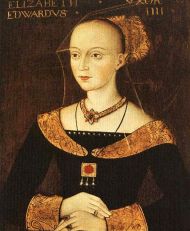 The Fogge family was one of the first families in Kent, England. The Fogge family was one of the first families in Kent, England. Sir John Fogge built and endowed the noble Church and the College at Ashford, Kent circa 1450. Sir John was a Privy Councillor, Comptroller, and Treasurer of the Household of Edward IV and Chamberlain jointly with Sir John Scott to Edward Prince of Wales (Edward V).
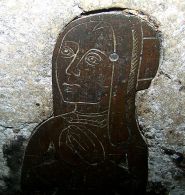 Sir John was keeper of the wardrobe to Henry VI in the last year of his reign. Fogge's switch from the Red Rose of Lancaster to the White Rose of York was no doubt due to his marriages; one to the Kyriel family and the Woodville family. Through out the many conflicts which arose with the War of the Roses, Sir John was lucky enough to survive, especially when Richard III came to the throne. Sir John was a supporter of Henry Tudor and reportedly had a role in the Battle of Bosworth field. Because of this Sir John's lands that were attained during King Richard's reign were restored as soon as Henry VII came to power. Sir John was keeper of the wardrobe to Henry VI in the last year of his reign. Fogge's switch from the Red Rose of Lancaster to the White Rose of York was no doubt due to his marriages; one to the Kyriel family and the Woodville family. Through out the many conflicts which arose with the War of the Roses, Sir John was lucky enough to survive, especially when Richard III came to the throne. Sir John was a supporter of Henry Tudor and reportedly had a role in the Battle of Bosworth field. Because of this Sir John's lands that were attained during King Richard's reign were restored as soon as Henry VII came to power.
He was married to Alice, daughter of Sir William Hawte of Hautsbourne Kent and Joan Elizabeth Woodville, aunt to queen consort Elizabeth Woodville (above left); mother of Elizabeth of York (King Henry VIII's mother); hence making Alice a first cousin of the Queen. When Elizabeth became queen, she brought her favorite female relatives to court. Lady Alice Fogge was one of the five ladies-in-waiting to the queen during the 1460s.
| Sir William (the elder) Parr
1st Baron Parr of Kendal
(ABT 1434 - ABT 1483)
Father of Sir Thomas Parr
| Hon. Elizabeth Fitzhugh
Lady Parr of Kendal
(ABT 1455/65 - BEF 1507 / 28 Feb 1513)
Mother of Sir Thomas Parr
| Sir Thomas Green, Lord of Greene's Norton VII
(1459 - 9 Nov 1506)
Father of Maud Green
| Joan Fogge
(b. 1468)
Mother of Maud Green
|
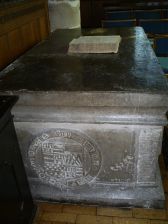 Sir William (elder) Parr was born at Kendal Castle in Westmoreland, England. He was an English courtier and soldier. William was in high favour with Edward IV and was made a knight of the Garter by Edward IV of England. He was on the side of the Neville's at Banbury in 1469, was sent by George Plantagenet, 1st Duke of Clarence and Richard Neville, 16th Earl of Warwick to Edward in March 1470, just before the battle of Lose-Coat-Fields, and was entrusted by Edward with his answer. When Edward IV returned from exile in 1471, Parr met him at Nottingham, and was rewarded with the comptrollership of the household, which he held till Edward's death. He swore to recognise Edward, Prince of Wales, as heir to the throne in 1472, and was exempted from the resumption act of 1473. Parr sat as knight of the shire for Westmoreland in 1467 and 1473, and was sheriff of Cumberland from 1473 to 1483. He was sent to the Kingdom of Scotland to arrange about the breaches of the truce probably in 1479. He was exempted from the act of apparel in 1482, was chief commissioner for exercising the office of constable of England in 1483, and took part in the funeral of Edward IV. It seems probable that he died about this time, and that the William, Baron Parr (the elder) was present at the meeting of Henry VII of England and Philip I of Castile at Windsor, in 1506, was his second son. After his death, his wife Elizabeth, would go on to marry Nicholas Vaux, [later 1st Baron Vaux of Harrowden] and have three daughters. One of these daughters included Katherine Vaux who married Sir George Throckmorton. The family caused somewhat of an uprising during the reign's of King Henry VIII and Elizabeth I due to their strong faith in Catholicism. Sir William (elder) Parr was born at Kendal Castle in Westmoreland, England. He was an English courtier and soldier. William was in high favour with Edward IV and was made a knight of the Garter by Edward IV of England. He was on the side of the Neville's at Banbury in 1469, was sent by George Plantagenet, 1st Duke of Clarence and Richard Neville, 16th Earl of Warwick to Edward in March 1470, just before the battle of Lose-Coat-Fields, and was entrusted by Edward with his answer. When Edward IV returned from exile in 1471, Parr met him at Nottingham, and was rewarded with the comptrollership of the household, which he held till Edward's death. He swore to recognise Edward, Prince of Wales, as heir to the throne in 1472, and was exempted from the resumption act of 1473. Parr sat as knight of the shire for Westmoreland in 1467 and 1473, and was sheriff of Cumberland from 1473 to 1483. He was sent to the Kingdom of Scotland to arrange about the breaches of the truce probably in 1479. He was exempted from the act of apparel in 1482, was chief commissioner for exercising the office of constable of England in 1483, and took part in the funeral of Edward IV. It seems probable that he died about this time, and that the William, Baron Parr (the elder) was present at the meeting of Henry VII of England and Philip I of Castile at Windsor, in 1506, was his second son. After his death, his wife Elizabeth, would go on to marry Nicholas Vaux, [later 1st Baron Vaux of Harrowden] and have three daughters. One of these daughters included Katherine Vaux who married Sir George Throckmorton. The family caused somewhat of an uprising during the reign's of King Henry VIII and Elizabeth I due to their strong faith in Catholicism.
Never the less, Queen Catherine Parr loved her cousins and found positions for them in her household and other stations at court. Catherine's cousin, Elizabeth "Bess" Throckmorton, would become lady-in-waiting to Elizabeth I and marry Sir Walter Raleigh.
|
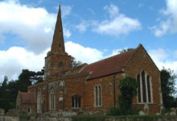 Sir Thomas Greene. He received Broughton, Green's Norton and large Sir Thomas Greene. He received Broughton, Green's Norton and large
monetary grants. This line of Green's was buried at St. Bartholomew's Church at
Green's Norton. The family lived at Green's Norton from the fourteenth century up to his time of death in 1506.
Thomas was the leading family name making Sir Thomas the 7th in a row to receive the name. The line of Thomas' started with Sir Thomas de Green born abt 1343. This Thomas was a descendant of Sir Henry de Greene and Katherine Drayton (ancestress to the Marbury family from which Anne Hutchinson and her family descended).
Sir Thomas married Lady Joan Fogge, the daughter of Sir John of Ashford Fogge and the granddaughter of Sir William. The Fogge family was a distinguished family of Kent. There they were owners of vast estates.
Sir Thomas' traits were that of any man of the time. He was conservative in religion, quarrelsome, conniving, and was one to take the law into his own hands. Sir Thomas was sent to the Tower of London due to trumped up charges of treason and died there in 1506.
As the last of the line, dying in 1506, Thomas left two motherless daughters. One,
Matilda, married Sir Thomas Parr and had Catherine. The other named Anne, who would go on to marry the second husband of Elizabeth Fitzhugh, Sir Nicholas Vaux, Baron of Harrowden. Anne's son, the 2nd Lord Vaux, would marry Queen Catherine Parr's paternal cousin, Elizabeth Cheney. Elizabeth was the daughter of Sir Thomas Cheney and Anne Parr.
This Green line descended from Alfred 'the great', King of England.
Sir Thomas' ancestors were Sir Thomas Green and Mary Talbot. Their son, Thomas married firstly, Philippa de Ferrers and secondly Marina Beler, heiress of John Beler, Esq. Thomas and Philippa's son, yet another Thomas married into the Throckmorton family. Thomas and Marina would be ancestors to Elizabeth "Bess" Hardwick, lady-in-waiting to Elizabeth I.
| | William was in high favour with Edward IV and was made a knight of the Garter by Edward IV of England. He was on the side of the Neville's at Banbury in 1469, was sent by George Plantagenet, 1st Duke of Clarence and Richard Neville, 16th Earl of Warwick to Edward in March 1470, just before the battle of Lose-Coat-Fields, and was entrusted by Edward with his answer. | Sir Thomas Parr,
Lord of Kendal, Westmoreland
(1478 - 11 November 1517)
Thomas Parr was the descendant of a rough and ready northern gentry clan, the Parrs of Kendal. They had been, after the crown, the most influential presence in southern Westmoreland since 1381. His mother and grandmother before him were royal ladies-in-waiting giving Sir Thomas an upbringing at court. Sir Thomas was most likely a scholar under Maurice Westbury of Oxford who was installed as a teacher by Lady Margaret Beaufort at her estate of Colyweston. Lady Margaret was the mother of King Henry VII. It was at Colyweston that certain gentleman, including the son of the Earl of Westmoreland, were taught not only education but important future political connections. Thomas' father, Sir William had once been Margaret Beaufort's revisionary heir to her substantial lands in Westmoreland, known as the Richmond fee. Thomas' grandmother's family, the Vaux's, were close to and had had a long time relationship with Margaret. Through his education Thomas was a scholar in Latin, Greek, and modern languages. He was a master of wards. Parr was found of Sir Thomas More. He found his ways of education to be useful and looked to his household when it was time to educate his own children. Sir Thomas More's first wife, Jane, was a niece of Parrs. Therefore making More an in-law. Parr was also an advocate of his cousin, Sir Cuthbert Tunstall's teachings; which included that of mathematics; something that his daughter Catherine would use later in her life as the lady of many households.
Under the rule of Henry VIII the family flourished. Influence, income, and titles increased as the Parrs became more involved with the court of Henry VIII. His wife, Maud, became a lady-in-waiting to Queen Katherine of Aragon. Shortly before Catherine's birth, the two had bought a house in Blackfriars, London. Sir Thomas was popular with the King and has served at court with such men as Sir Thomas More. Although he was rich in land and money, Thomas never attained the title of Baron. In November 1517, Thomas fell ill. He left a will for his wife and children leaving dowry's and his inheritance to his only son, but as he died before any of his children were of age, Maud along with Cuthbert Tunstall, their uncle Sir William Parr, and Dr. Melton were made executors. Sir Thomas died in his home at Blackfriars, London on 11 November 1517 leaving two daughters and a son; Sir William Parr, Anne Parr (Lady Herbert, Countess of Pembroke) and Queen Catherine. He was buried in St. Anne's Church, Blackfriars, beneath an elaborate tomb.
| Matilda 'Maud' Green
of
Greene's Norton
(1492 - 1531)
Maud was born in Northamptonshire. Her mother died when she was an infant. She became a lady-in-waiting to Queen Katherine of Aragon, the first wife of King Henry VIII sometime after 11 June 1509. She was in constant attendance upon the Queen and was allocated her own rooms at Court on a permanent basis. Maud is said to have named her daughter Catherine after Queen Katherine of Aragon, who was also godmother to the child.
Maud had married Sir Thomas Parr, the eldest son of Sir William Parr and Elizabeth FitzHugh in 1508 when she was about thirteen years old, before she had gone to the Court. He was the Sheriff of Northamptonshire, master of the wards and comptroller to the King's household. Maud and Thomas had three children. The Parr family lived at Kendal Castle, Westmoreland, and Parr House which was located on The Strand in London. Thomas Parr died leaving Maud a widow at the age of twenty-two. She chose not to remarry for fear of jeopardising the huge inheritance she held in trust for her children.
After her husbands death, Maud proved that she was perfectly capable of running her own affairs and her husbands estates. Maud was fluent in French and like her royal mistress Queen Katherine believed in obtaining the very best in education for her children. It was probably from her mother that Catherine learned of the simples, herbals, and medicines that aided her in caring for two of her husbands.
Maud was a very intelligent and well-educated woman. She was the head of the Royal School at court, where Catherine was educated alongside her sister Anne and other daughters of the nobility. There Catherine would have been taught French, Latin, philosophy, theology, and the Classics. Lady Parr had already taught her children to read and write when they were small. When it came time for her children to marry she carefully set out to find the best match with the help of male family members.
| SOURCES:
- James, Susan. 'Catherine Parr: Henry VIII's Last Love.'
- Weir, Alison. Britain's Royal Family: A Complete Genealogy (London, U.K.: The Bodley Head, 1999) [not completely reliable]
- George Edward Cokayne, editor, The Complete Baronetage, 5 volumes (no date (c. 1900); reprint, Gloucester, U.K.: Alan Sutton Publishing, 1983)
- G.E. Cokayne; with Vicary Gibbs, H.A. Doubleday, Geoffrey H. White, Duncan Warrand and Lord Howard de Walden, editors, The Complete Peerage of England, Scotland, Ireland, Great Britain and the United Kingdom, Extant, Extinct or Dormant, new ed., 13 volumes in 14 (1910-1959; reprint in 6 volumes, Gloucester, U.K.: Alan Sutton Publishing, 2000)
- Charles Mosley, editor, Burke's Peerage, Baronetage & Knightage, 107th edition, 3 volumes (Wilmington, Delaware, U.S.A.: Burke's Peerage (Genealogical Books) Ltd, 2003)
- Peter W. Hammond, editor, The Complete Peerage or a History of the House of Lords and All its Members From the Earliest Times, Volume XIV: Addenda & Corrigenda (Stroud, Gloucestershire, U.K.: Sutton Publishing, 1998)
| LINKS:
|
|









